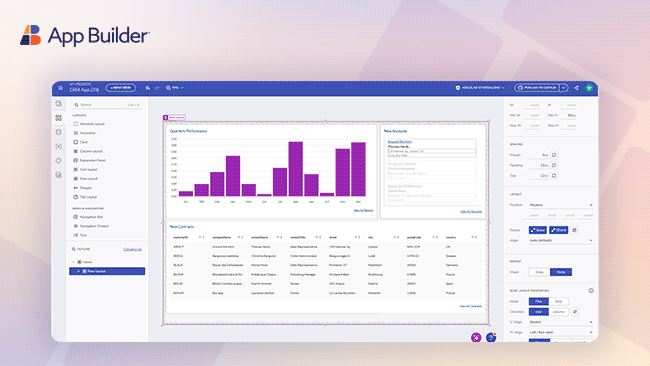

What Is Digital Innovation & Why Is It Important?
Who are the most successful digital innovators? These are the people who realize that it takes more than just harnessing new technology for efficiency to digitally innovate a business. It requires leveraging these technologies to create new solutions that drive growth, competitive advantage, and faster time to market, while addressing emerging needs and opportunities at […]
Who are the most successful digital innovators? These are the people who realize that it takes more than just harnessing new technology for efficiency to digitally innovate a business. It requires leveraging these technologies to create new solutions that drive growth, competitive advantage, and faster time to market, while addressing emerging needs and opportunities at the same time.
They understand that digital innovation is also about building a culture of agility, productivity, and collaboration where teams can operate at full capacity. It’s about knowing that processes must be optimized, reducing resource constraints and dependency on traditional and heavy IT development cycles so the company can more effectively respond to market changes in real-time and increase ROI. And most importantly, it is about integrating and crafting novel solutions.
But…
What Is Digital Innovation?
Is it the power of change? In essence, digital innovation is the process of adopting digital technologies in a strategic way with the primary goal of enhancing business processes, creating cutting-edge products or services, delivering better UX, and responding to the ever-changing market.
Why Is Digital Innovation Important?
In times when developing enterprise-grade applications for different frameworks no longer requires long timelines or complex hand-coding, businesses face a clear choice: drive disruption or be overtaken by it.
With the right digital innovation tools in place, then, they can streamline operations, reduce costs, drive growth, and respond to market demands quickly and efficiently. According to Forrester, “91% of IT and business decision-makers responsible for digital transformation initiatives at enterprises in the US, the UK, Canada, and Australia use low code to improve existing IT capabilities to promote agility and innovation.” So, low code here enters the game to benefit organizations and empower them so they can make this necessary step toward innovation.
The Key Benefits of Digital Innovation
Ability To Stay Competitive
With solid competition out there, if companies don’t innovate, they get outpaced by organizations that have already established digital innovation strategies. Lacking the right tools and process automation, businesses may miss out on market opportunities, fail to comply with customer expectations, and cannot adapt to market changes.
Enhanced Customer Experiences
Rushing to meet deadlines can lead to compromises in product quality. Teams may cut corners in testing, code review, and documentation, resulting in software that is prone to bugs, performance issues, and security vulnerabilities. However, working with digital innovation in mind, companies can respond to the expectations of consumers by updating development processes and delivering solutions much faster.
Improved Efficiency and Scalability
By adopting a future-proof strategy and innovative solutions, companies can effectively overcome major challenges such as heavy workloads and difficulty scaling projects quickly. Managers can strategically allocate developers’ skillsets to tasks for maximum efficiency and gain unparalleled team productivity to meet project goals. Additionally, they can overcome extensive workloads and allow your team to build apps fast and scale projects with a reduced reliance on large development teams.
Driving New Revenue Streams
No one wants to miss market opportunities. By leveraging emerging technologies, executives will help their company avoid delayed releases or poor product performance, as time to market pressures can result in a competitive disadvantage. Competitors who can deliver high-quality solutions faster will capture market share, customer mindshare, and revenue opportunities. After all, timely releases are crucial for remaining relevant and competitive today.
Having Agility and Adaptability
If companies fail to adapt to market conditions, this can lead to losing their competitive advantage, customers, and even revenue. As opposed, organizations that are already more agile and responsive actually have an advantage. Embracing digital innovation, they are in a position that allows them to quickly respond to changing market conditions using the right tools and methods.
Digital Innovation Vs. Digital Transformation
When people often talk about digital innovation, they presume it’s the same as digital transformation. Despite the fact the terms are used interchangeably, there is a difference. Digital transformation is about integrating digital technology across different parts of the business to change how an organization works and delivers value to its customers. On the other hand, digital innovation is about introducing or developing new digital solutions with innovation tools.
With this in mind, digital innovation can be applied to the following key focus areas:
- User experience
- Customer engagement
- Process efficiency
- Data-driven decision making
- Product and service deployment
- Collaboration and productivity
How To Track Your Entire Digital Transformation?
The easiest way to do this would be through benchmarks or KPIs that you can use to assess and measure the progress or success of your digital transformation.
Some questions to consider here:
- How innovative is your current technology strategy? Does it align with digital innovation at all? Do you plan to use tools like AI or low-code tools? Are they relevant to your business needs?
- What challenges or opportunities in your industry can you address with digital innovation?
- Are your teams consistently meeting deadlines, staying within budget, and delivering projects ahead of schedule?
- How can you further accelerate your time to market and achieve faster profits? Equipping your team with the tools they need to maximize their productivity is the easiest way to ensure this.
- How fast is your time to market? Whether it is shipping a new feature or deploying a new product that will give you a significant advantage over the competition, and in turn, you will be able to generate revenue faster.
- Is your team still capable of building their minimal viable product with the features they need by using just a low-code platform, and if so, are they achieving the same results?
- How much time are you minimizing on the critical manual tasks you prefer to be automated?
- What’s the number one thing that slows down your processes? For instance, a lot of development time right now is being spent on tasks that developers either don’t have the skill set for or don’t enjoy. This, in return, hinders the productivity of your entire team.
- How much does your business spend? What are your actual cost savings achieved through a reduced development time?
- Are you decreasing your development hours and reducing technical debt? Is there less dependency on highly skilled developers, decreasing your maintenance costs compared to a traditional app development method?
And in order to track all this, look at metrics such as:
- Customer satisfaction, customer retention, or more people coming back to use your finished applications.
- Conversion rates, i.e., how many people go from a trial to a converted customer.
- Sales growth and the average transactional value you can achieve before implementation and after.
- Project timelines – before and after – and the exact time it now takes your teams to develop a new component or build an entire app and generate the code.
Streamlining Digital Innovation with Low-Code App Builder

One of the biggest barriers to innovation has been the complexity of developing and integrating new solutions. However, tools like our App Builder have become an invaluable solution to this challenge, delivering seamless integration and compatibility. This allows non-developers—PMs, CIOs, or other stakeholders—to create and test digital innovations without heavily relying on IT teams or extensive coding skills.
Accelerate Innovation
App Builder provides a library of pre-built, drag-and-drop components, templates, and layouts that users can leverage to accelerate development. These reusable building blocks provide common functionalities, such as user authentication, data management, and UI elements, allowing users to assemble applications quickly. There are also code generation and instant code preview features that ensure faster time to market, saving time and effort.
Flexibility and Integration
The tool supports integration with external systems, services, and data sources, enabling users to extend the functionality of their applications seamlessly. Users can leverage built-in integrations, connectors, and APIs to connect with third-party applications such as Sketch and Figma for complete design-to-code automation.
Ensure Rapid Application Development
App Builder enables quicker prototyping, rapid application development (RAD), and deployment of applications, allowing users to iterate on ideas and respond to market demands quickly. Streamlining the development process also reduces development costs, allowing companies to stretch their IT budgets further while introducing innovation.
Keeping Pace With Market Innovations
With AI starting to dominate the digital world, it’s unthinkable not to ensure AI capabilities that will significantly boost digital innovation. And App Builder AI offers automation capabilities that help users streamline development, optimize workflows, and enhance user experiences. Users can leverage AI-driven features such as natural language processing, predictive analytics, and chatbots to automate routine tasks, personalize experiences, and gain insights from data.
Resource Optimization and Allocation
Another way in which App Builder fosters digital innovation is by allowing managers to allocate developers’ skillsets to tasks strategically. This ensures maximum efficiency and unparalleled team productivity so they can meet project goals and overcome extensive workloads.
Wrap Up…
The tech world is expanding and changing fast and digital innovation tools like App Builder are here to drive digital innovation and transformation. While many technologies couldn’t really remain on the market, low-code platforms have become a standout trend. For the last couple of years, they have been redefining roles, processes, and entire business models through low-code capabilities. Reflecting a positive long-term trajectory, this allows CTOs, CIOs, Dev Team Leaders, and other executives to quickly prototype and test new ideas, facilitate innovation, and maintain continuous improvement. These are things that are not short-term benefits but contribute to ongoing, future-oriented progress.



